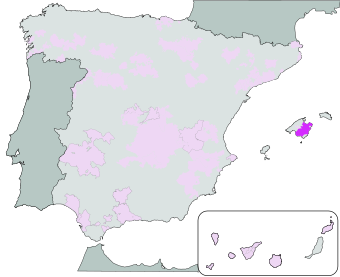Pla i Llevant (DO) facts for kids
| Wine region | |

Pla i Llevant DOP in the region of Balearic Islands
|
|
| Official name | D.O.P. Pla i Llevant |
|---|---|
| Type | Denominación de Origen Protegida (DOP) |
| Year established | 2001 |
| Country | Spain |
| No. of vineyards | 439 hectares (1,085 acres) |
| No. of wineries | 13 |
| Wine produced | 15,189 hectolitres |
| Comments | Data for 2016 / 2017 |
Pla i Llevant is a special protected area in Mallorca, an island in Spain. This area is known for making unique wines. The full name, Denominació d'Origen Protegida, means "Protected Designation of Origin" in Catalan. The name "Pla i Llevant" itself means "plain and east coast" in the local language.
Contents
History of Winemaking in Pla i Llevant
Winemaking started on Mallorca a very long time ago. The ancient Romans brought grape growing to the island in 121 BC. This happened when Quintus Caecilius Metellus Pius took control of the island for Rome. A famous writer named Pliny the Elder even wrote about Mallorca's wines in the 1st century AD.
Later, during the time of the Moors, winemaking continued. Even though the Koran usually forbids alcohol, grapes were still grown. When King Jaume I conquered the island in 1230, he was offered excellent wine as a peace gift.
In the late 1800s, a tiny bug called phylloxera caused huge problems. This bug destroyed most of the grapevines on Mallorca. Before this, about 27,000 hectares (67,000 acres) of land had grapevines. Mallorca used to export a lot of wine every year. After the bug attack, many farmers planted almond trees instead of grapes.
However, in the late 1900s, winemaking started to grow again. Tourists visiting Mallorca wanted good quality local wine. This helped the wine industry make a comeback. In 1991, the area was first recognized for its local wines. Then, in 2001, about 250 hectares (620 acres) were given the special "DO" status. This means their wines meet high quality standards.
Geography of the Vineyards
The vineyards of Pla i Llevant are found in the areas of Felanitx and Manacor. These places are in the central and eastern parts of Mallorca.
The vineyards are not very high up. They are usually around 100 meters (330 feet) above sea level.
Soil Types for Grape Growing
The soils in Pla i Llevant are quite good for growing grapes. They have a lot of clay and limestone. These soils come from lime-bearing rocks like marl and dolomite.
The soil drains water well, which helps grape roots grow deep. The soils are often red because of iron oxide. Some soils are white due to clays, calcium carbonate, and magnesium.
Climate Conditions
Pla i Llevant has a Mediterranean climate. This means it has long, dry, and hot summers. The winters are short and mild.
In winter, a strong wind often blows, especially in the flat areas. There is not much risk of frost or fog. The area gets about 425 millimeters (17 inches) of rain each year. Most of this rain falls in autumn, often in strong storms.
Grape Varieties Grown Here
Many different types of grapes are allowed to be grown in Pla i Llevant.
- Red Grapes: These include Cabernet Sauvignon, Callet, Fogoneu, Manto Negro, Merlot, Monastrell, Pinot Noir, Syrah, Tempranillo, and Gorgollassa.
- White Grapes: These are Chardonnay, Macabeo, Moscatel de Alejandría, Moscatel de Grano Menudo, Parellada, Prensal Blanc, Riesling, Giró Ros, and Viognier.
Older grapevines are often planted as low bushes, which is called en vaso. Newer vines are usually grown on trellises, called en espaldera. This means the vines are supported by wires. There are usually between 2,500 and 5,000 grapevines per hectare (1,000 to 2,000 vines per acre).
See also
 In Spanish: Pla i Llevant para niños
In Spanish: Pla i Llevant para niños

